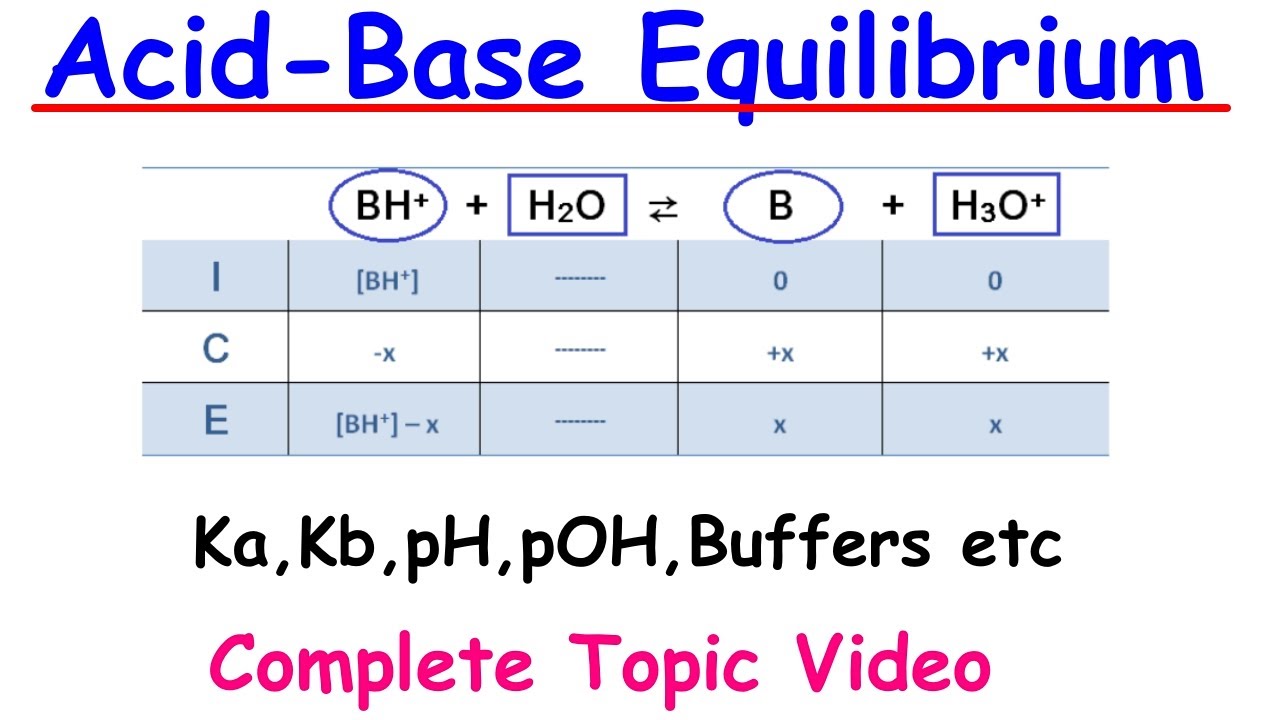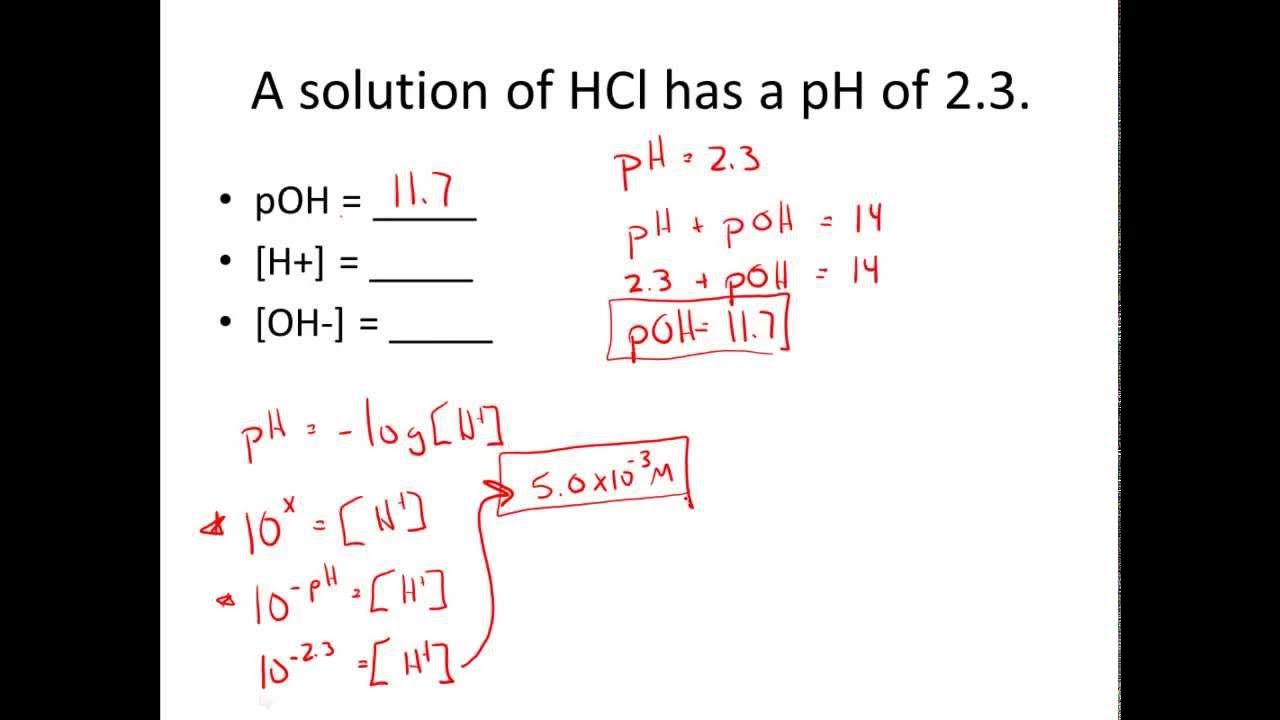pH, pOH, H3O+, OH-, Kw, Ka, Kb, pKa, and pKb Basic Calculations -Acids and Bases Chemistry Problems
TLDRThis video script offers a comprehensive guide to solving basic acid-based chemistry problems, focusing on understanding pH and Poh calculations. It explains the relationship between hydronium ion concentration and pH, and hydroxide ion concentration and Poh, emphasizing the use of logarithms and the importance of the auto-ionization constant of water (kW). The script also covers how to calculate pKa and pKb from the acid dissociation constant (KA), and how to determine the nature of a solution as acidic, basic, or neutral based on its pH and Poh values. The video aims to enhance the viewer's ability to tackle acid-base chemistry problems with clarity and confidence.
Takeaways
- 📚 The pH of a solution is calculated as the negative logarithm of the hydronium ion (H3O+) concentration.
- 🔢 For estimation purposes, if the hydronium ion concentration is less than 1, the pH will be between 3 and 4; if greater than 1, the pH will be between 4 and 5.
- 📈 The pH and pOH of a solution at 25°C add up to 14, reflecting the auto-ionization constant of water (kW = 1×10^-14).
- 🧪 To calculate pOH from given pH, use the formula: pOH = 14 - pH.
- 🧬 The relationship between the dissociation constants of an acid is given by: PKA + PKB = 14, where PKA is the negative logarithm of the acid dissociation constant (KA) and PKB is the negative logarithm of the base dissociation constant (KB).
- 🌡️ At 25°C, a solution is acidic if its pH is less than 7, neutral if its pH is equal to 7, and basic if its pH is greater than 7.
- 📊 To find the hydroxide concentration from the pOH, use the formula: [OH-] = 10^(-pOH).
- 🔍 The acid dissociation constant (KA) is calculated as the negative logarithm of the given value, similar to how pH is calculated.
- 📈 The base dissociation constant (KB) can be found using the relationship: KB = 10^(-PKB), where PKB is calculated from the pKA.
- 🌟 In the context of water autoionization at 25°C, the hydroxide concentration can also be calculated using the formula: [OH-] = kW / [H3O+].
- 📝 To calculate the pH from the hydroxide concentration, first determine the pOH using the negative logarithm of the hydroxide concentration, then use the relationship pH = 14 - pOH.
Q & A
What is the formula to calculate pH?
-The formula to calculate pH is pH = -log[H3O+], where [H3O+] represents the hydronium ion concentration.
How do you estimate the pH of a solution if the hydronium ion concentration is 2.5 × 10^-4 M?
-To estimate the pH, first recognize that the exponent (-4) is close to the pH value. Since the concentration is greater than 1, the pH will be between 3 and 4. The exact calculation yields a pH of 3.6.
What is the relationship between pH and Poh in a solution at 25°C?
-At 25°C, the relationship between pH and Poh in a solution is given by the equation pH + Poh = 14, due to the auto-ionization constant of water (kW = 1 × 10^-14).
How can you calculate the hydroxide concentration given the Poh of a solution?
-To calculate the hydroxide concentration from the Poh, use the formula [OH-] = 10^(-Poh). For example, if Poh is 3.8, the hydroxide concentration is 1.58 × 10^-4 M.
What is the formula to calculate pKa from the acid dissociation constant (Ka)?
-The formula to calculate pKa from Ka is pKa = -log(Ka). This gives you the negative logarithm of the acid dissociation constant.
How do you find the pKb value of an acid knowing its pKa?
-Since PKA + PKB = 14, you can find the pKb value by subtracting the pKa value from 14. For example, if pKa is 3.7, pKb is 14 - 3.7 = 10.3.
What is the auto-ionization constant of water (kW) at 25°C?
-The auto-ionization constant of water (kW) at 25°C is 1 × 10^-14, representing the equilibrium constant for the ionization of water into hydronium and hydroxide ions.
How can you calculate the hydroxide concentration in a solution with a given hydronium ion concentration?
-You can calculate the hydroxide concentration using the autoionization constant of water (kW). [OH-] = kW / [H3O+]. For example, with [H3O+] = 7.1 × 10^-2 M, [OH-] = 1 × 10^-14 / 7.1 × 10^-2 M.
What is the formula to calculate the base dissociation constant (KB) from the pKB value?
-The formula to calculate KB from pKB is KB = 10^(-pKB). This gives you the base dissociation constant when provided with the negative logarithm of the base dissociation constant.
How do you determine if a solution is acidic, basic, or neutral based on its pH value?
-A solution is considered acidic if its pH is less than 7, neutral if the pH is equal to 7, and basic if the pH is greater than 7 at 25°C.
What is the relationship between hydronium ion concentration [H3O+] and hydroxide ion concentration [OH-] in a basic solution?
-In a basic solution, the concentration of hydroxide ions [OH-] is greater than the concentration of hydronium ions [H3O+].
How do you calculate the Poh of a solution if the hydronium ion concentration [H3O+] is 4.2 × 10^-3 M?
-To calculate the Poh, use the formula Poh = 14 - pH. First, calculate the pH which is pH = -log[H3O+]. With [H3O+] = 4.2 × 10^-3 M, pH = 2.37, and thus Poh = 14 - 2.37 = 11.63.
Outlines
📚 Introduction to Acid-Base Calculations
This paragraph introduces viewers to the basics of acid-base chemistry calculations, emphasizing the importance of understanding common equations and their applications. The key concept discussed is the definition of pH as the negative logarithm of the hydronium ion concentration. The video provides a method for estimating pH values without a calculator by examining the exponent and applying basic logarithmic principles. It also introduces the relationship between pH and Poh, and how these values can be used to determine if a solution is acidic, basic, or neutral at 25 degrees Celsius. The paragraph concludes with a problem-solving example that demonstrates these concepts in practice.
🧪 Calculation of Poh and Hydroxide Concentration
The second paragraph delves into the calculation of Poh and hydroxide ion concentration in a solution. It begins by guiding the viewer through the process of determining the Poh from a given hydronium ion concentration and vice versa. The video then explains how to calculate the pKa and pKb values of an acid using the acid dissociation constant (Ka) and the relationship between pH, Poh, and the auto-ionization constant of water (kW). The paragraph includes examples that illustrate these calculations, reinforcing the principles of acid-base chemistry and providing practical problem-solving techniques.
📈 Advanced Acid-Base Calculation Techniques
The final paragraph focuses on advanced acid-base calculations, including the determination of the base dissociation constant (KB) from the acid dissociation constant (KA) and the calculation of the pH of a solution given the hydroxide ion concentration. The video introduces the concept of P Ka and PKB, explaining their relationship with KA and KB, and how they can be used to calculate the pH of a solution. The paragraph concludes with a comprehensive review of the essential formulas needed for acid-base chemistry, such as the relationships between pH, Poh, and the concentrations of hydronium and hydroxide ions. This summary aims to solidify the viewer's understanding of the fundamental concepts and formulas in acid-base chemistry.
Mindmap
Keywords
💡pH
💡Poh
💡hydronium ion
💡hydroxide ion
💡acid dissociation constant (Ka)
💡base dissociation constant (Kb)
💡auto-ionization constant of water (kW)
💡logarithm
💡concentration
💡equilibrium
💡acid-base chemistry
💡calculation
Highlights
The pH is equal to the negative log of the hydronium ion concentration.
If the hydronium ion concentration is 2.5 times 10 to the minus four moles per liter, the pH is estimated to be between 3 to 4.
The exact pH value can be calculated using a calculator, resulting in a pH of 3.6 for the given example.
The pH plus the Poh of a solution must add up to 14 at 25 degrees Celsius.
If the pH is less than 7, the solution is acidic; if the pH is greater than 7, the solution is basic.
The Poh is equal to the negative log of the hydroxide concentration.
The hydroxide concentration can be calculated using the formula 10 raised to the negative Poh.
The Poh can be calculated by subtracting the pH from 14.
The pKa value is the negative log of the acid dissociation constant (KA).
The PKB value is calculated by subtracting the pKa from 14.
The KB value, the base dissociation constant, is calculated using 10 raised to the negative PKB.
The autoionization constant of water (kW) is 1 times 10 to the minus 14 at 25 degrees Celsius.
The hydroxide concentration can also be found using the formula kW divided by the hydronium ion concentration.
The pKa of an acid is 3.7, and the KB value can be calculated using the formula 10 to the negative P KB.
The pH of a solution can be calculated by first determining the Poh, which is the negative log of the hydroxide concentration.
The pH is then found by subtracting the Poh from 14.
In acid-base chemistry, the sum of PKA and PKB equals 14, and the product of KA and KB equals 1 times 10 to the minus 14.
Transcripts
Browse More Related Video

pH of Weak Acids and Bases - Percent Ionization - Ka & Kb

pH, pOH of strong acids and bases | Chemistry | Khan Academy

AutoIonization of Water, Ion Product Constant - Kw, Calculating H3O+, OH-, and pH Using Ice Tables

Acid Base Equilibrium Full Topic Video

pH and pOH: Crash Course Chemistry #30

Given pH & pOH, Solve for [H+] & [OH-] Practice Problems
5.0 / 5 (0 votes)
Thanks for rating: